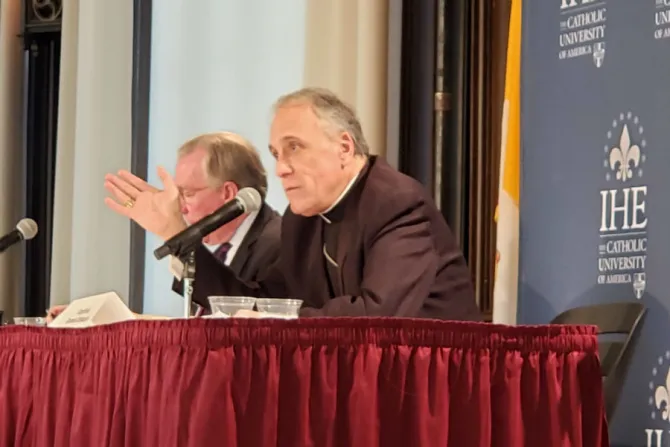Washington D.C., Feb 6, 2019 / 15:00 pm
The Church can look to marriage and the cross for insights into restoring trust and addressing the sexual abuse crisis, a conference on lay involvement was told Wednesday.
"The cross is our only hope," Cardinal Daniel DiNardo told attendees at the one-day event, held at the Catholic University of America.
"But," the USCCB president and Archbishop of Galveston-Houston said, "I do not think we are persuaded by the cross, or if we were, something has happened. The cross is not upheld as the source of who we are."
The February 6 conference, titled The Role of the Laity in Responding to the Crisis: Theological and Historical Foundations, was hosted by Catholic University's Institute of Human Ecology (IHE), and began with speeches from DiNardo and John Garvey, president of Catholic University.
Garvey outlined the breakdown of trust between the faithful and bishops, saying that "We in the Church are like a suspicious wife whose husband comes in late and says he's been at work." He went on to discuss how marriage offered an apt model for the relationship of the hierarchy with the faithful, and how to rebuild it.
The event was part of a series hosted by the IHE under the title Healing the Breach of Trust, and offered lectures and discussions across a range of disciplines. Prof. Joseph Capizzi, executive director of the IHE, told CNA that addressing the abuse crisis "required a more sustained response than it was receiving" and inspired the calendar of events.
Garvey opened the conference by noting that current scandals facing the Church were as much about how bishops have acted in their role as administrators as about the sexual abuse of minors by clergy.
The challenges faced by bishops, Garvey observed, are the same as those faced by the heads of most major organizations, and he suggested that practical lessons readily presented themselves.
(Story continues below)
In the face of the sexual abuse crisis, "the Church is not the first or the only organization to confront the problem, nor are bishops the only professionals concerned with rooting it out," Garvey said. Instead, there is a wealth of experience available from parents, lawyers, and other experts on which the Church could draw; the question was how best to do it.
Practical and structural proposals to create new, lay-led oversight or reporting structures for bishops are an idea, Garvey said, but need to be considered with an understanding of the Church.
Garvey noted the temptation to offer reforms that mirror the democratic separation of powers and system of checks and balances, something out of step with the Church's existence as a hierarchy under the guidance of the bishops and the Holy Father.
"I think it would be helpful if we set to one side the notions of power and authority, and the use of constitutional metaphors," Garvey suggested. Instead, he proposed considering the relationship of a bishop to the faithful as a marriage, noting the exchange of consent and a ring in episcopal consecration.
Offering examples from his own decades of marriage, Garvey noted that "a necessary rule in marriage is that you have to be completely honest and transparent with your spouse."
"Without trust you cannot build a relationship, and that is what we have lost," he said, citing the McCarrick scandal and the widespread suspicion of the faithful that other bishops knew about his alleged crimes.
"Bishops must be transparent and accountable to their flocks, as husbands and wives must be transparent and acknowledge one another. Talking about authority in this relationship is a kind of category mistake, we are obliged to one another by love."
Marriages, he observed, are not sustained by the invocation of authority or legal obligations but by the presumption and debts of mutual love, without which "marriages fall apart."
In his own remarks, Cardinal DiNardo said he had accepted the invitation to attend the event because it offered a chance for in depth discussion, noting that he was otherwise "subject to soundbites."
The cardinal reflected on the risk of viewing the sexual abuse crisis as a "merely organizational problem," noting the strong encouragement of Pope Francis to the U.S. bishops to pray and reflect on their personal conversion and communion as a necessary prelude to practical action.
DiNardo agreed that there was both scope and need for a wider collaborative role in Church affairs by the laity, and one that did not undermine the essential structure of the Church.
Instead, he said, there needed to be a "new ecclesial season" in which bishops led with a renewed emphasis on their pastoral duty as shepherds, rather than managers; two roles which were not in contradiction but rather imbalance.
Following a brief question and answer session, in which he addressed the outpouring of pain and criticism he had received from the faithful, DiNardo said that the source of healing for the Church lay in a renewed engagement with the reality of the cross and the witness of suffering of Christ for and in the Church.
Capizzi told CNA that the series of events was something the university saw as an expression of its mission as the national Catholic university.
"President Garvey believed that the academic resources at Catholic University, and its role in forming so many clergy and bishops, gave us a unique position - and a duty - to study and respond the problems facing the Church."
DiNardo closed the session by citing the witness of the early martyrs and said that the image of Christ on the cross was the witness the Church needed to offer the world.
"If we got people to get to that, we would have less problems -- we would have just as many problems, but we'd have less problems in terms how they are identified and where they are [in the Church]. The cross is everything."


